Albert Pujols: The Rise. – The Fall! – The Resurgence?
Tony LaRussa, one of Baseball greatest managers, had the good fortune of being the “skipper” of the St. Louis Cardinals at times when the team included two of the Game’s outstanding hitters. And it is fair to say that these players, Mark McGwire and Albert Pujols, had the good fortune of being managed by LaRussa.
McGwire was just finishing a long and illustrious career accredited with being known as one of History’s most prodigious sluggers. His legendary “tape-measure” home-runs” were initially lauded, but eventually disdained because of the implication that “steroid” use was a contributing factor in his uncommon and mythical feats of strength. Mostly gone unnoticed, after the “steroid-era” had been contested and virtually diminished from Baseball vernacular, was the fact that, from his inception into the Major Leagues, his tall, lean, and trim body, which bore no trace of the insidious trappings that Steroids ultimately produced, Mark was reputed as a power hitting “student-of-the-game”. It was his “Mechanical advantage” and his natural strength and ability that produced an abundance of home-runs in his formative “big-league” career. (He hit 49 Home Runs in his Rookie Year.)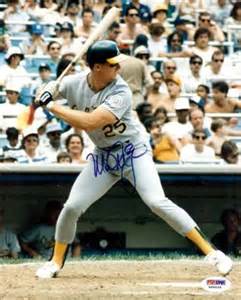
At the beginning, as well as at the end of his career, McGwire’s hallmark of stability and power lay in the position he took when he addressed the pitcher while in the batters’ box. He was a big and powerful man, but found no encumbrance while assuming a low, crouching stance. In fact it was this “stance” which afforded him the maximum of stability and strength which were the most contributable factors in his powerful swing, before and after steroid-accusations. It had been purported that his vision was less than the normal “20/20”, so to his credit, he eliminated that particular margin of error with his stance. Poor vision and at least a “minimum” stride were his two main foibles, which ultimately contributed to any batting dysfunction. His body’s altered structure seems to indicate steroid use; but if true, it’s too bad. He didn’t need it! His strength was at the top of the charts already.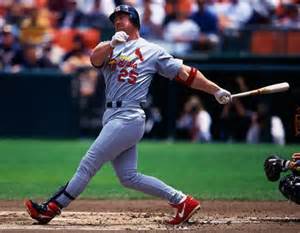
Albert Pujols had the good fortune and pleasure to play with Mark McGwire and for Tony LaRussa – he must have learned from both. Pujols is one of the strongest men in baseball, 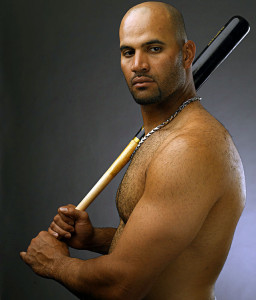 so he must realize that he doesn’t need any extra strength to be a consistent home-run hitter, or a .300 hitter. Whether he copied McGwire’s low stance, or found it himself is a credit to his good judgment. The other aspect of good-judgment on his part is his determination not-to- stride. For the first ten years of his Major-League career, these two characteristics of his batting regimen established him as arguably the best hitter in baseball. But it simply demonstrates how essential these two aspects are to uncommon batting proficiency.
so he must realize that he doesn’t need any extra strength to be a consistent home-run hitter, or a .300 hitter. Whether he copied McGwire’s low stance, or found it himself is a credit to his good judgment. The other aspect of good-judgment on his part is his determination not-to- stride. For the first ten years of his Major-League career, these two characteristics of his batting regimen established him as arguably the best hitter in baseball. But it simply demonstrates how essential these two aspects are to uncommon batting proficiency.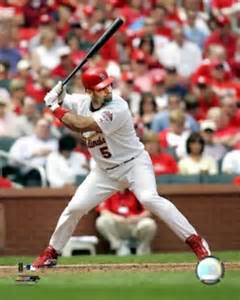
Two characteristics of Pujols’ batting style have become detrimental to his ultimate proficiency as a hitter that will forever place him below Barry Bonds as the “greatest-hitter” in baseball history. The fact that he holds his hands and bat high, while his arms are inordinately stretched out away from his body produce two distinguishable margins for error that will only exacerbate any slight ineffectiveness he may have previously experienced in his past-younger days.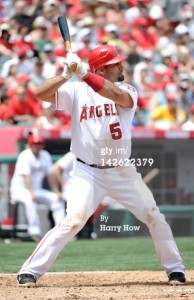
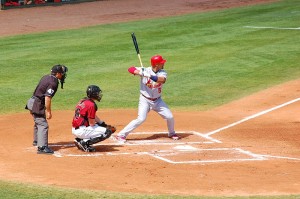
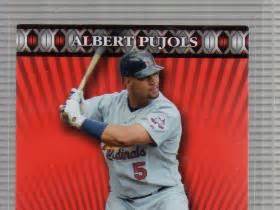
He apparently hasn’t recognized why he is a perennial leader in hitting into double-plays, even though he has consistently demonstrated magnificent hand-bat-eye coordination. In 2012, with the Angels, no one seemed to be able to help him understand why he was hitting so many bouncing balls for easy outs, to establish a batting average of sub-.200 in more than 100 at-bats. But it was in the 2011 season that started to show those detrimental effects and their imposing “doom”.
“Poor-Albert” was the best hitter in the “post-Bonds” era, and can regain that status, but not if he continues his present batting regimen, even if his patronizing commentators continue to predict that he will find his old self. The pitchers had been keeping the ball low, and with his bat high, had forced him to chop down and hit mostly ground balls, or bouncing balls, or pop-ups when the bat slices the front part of the ball. His first 2012 home-run was not that of a powerful Pujols swing, but rather a testament to his natural strength, barely making it over the left-field fence, on a pitcher’s breaking-ball mistake.
In his low stance Pujols should be able to hit the low pitch easily (as Barry Bonds did). Barry did not swing down on a low pitch, with the hope that his bat would strike it just right so as to slice the front end exactly right and get the required back-spin to carry the ball the distance for a home-run. He, as well as hitters like Ted Williams, realized that the bat had to come from behind and slightly below the pitched ball that was always descending into the strike-zone in order to hit it with maximum effectiveness at an angle close to 180 degrees.
Pujols’ slump is not due to some things that he is doing new and differently, but rather what he has been doing all along, but not thought of as detrimental to his over-all technique. The things being mentioned at this time are simply considered as margins of error that, if eliminated, will diminish or eliminate current mechanical flaws that impede proficiency.
- The low stance is requisite, but the slight bouncing of the body by the movement of knees moves the head and eyes and creates degrees of visual dysfunction.
- The “no-stride” is required to keep head and eyes at maximum stillness and secure ultimate visual acuity. But avoid locking the front foot into a position where the toes are almost pointing backward (Like Ryan Howard and Harold Baines). This is not necessary to keep the front side from “opening up” early. The negative effect occurs when the swing begins and the front leg is supposed to straighten as the backside is turning forward. The front knee cannot hold that position and the imminent sense of knee and ankle displacement abruptly jerks the body out of its smooth rhythm. (Harold Baines can attribute his knee problems to this uncompromising technique. And perhaps Ryan Howard, at times of batting deficiency.) All that is needed is for the front foot to plant itself firmly into the ground (at a 45 degree angle to the pitcher) to begin the swing. It doesn’t need to twist and plant.
- The problem with Albert holding his hands and bat high while having his arms extended away from his body is basically 2-fold:
- Even with Albert’s powerful shoulders, any extra weight extended away from the body will slow down the functionality of the body’s power source during the swing. Even more weight is added with the way he holds his bat in a horizontal position parallel to the ground.
- The hands and bat, if kept at that ultra-high position as the body begins turning into the swing, will have no choice but to swing downward at downward moving ball, even low in the strike-zone. The effect after contact is usually a ground or bouncing ball.
- It has not been noticed by this observer that Albert has been hitting the ball effectively to the opposite field, especially on pitches away. Perhaps balance is a problem. His stance may need to be widened slightly.
It is difficult for this observer to understand how a superb hitter, as Albert is, cannot detect what his problem is, and its remedy. He may very well feel that “no matter what, I’m going with what got me here, even if it kills me”. Well, I hope he has “9” lives, and the Angels have “Infinite Patience”. But there is an easier way — “adjust and adapt” with the help of an Absolute Principle.
Note: Before Albert started slumping, he held his bat more perpendicular to the ground while addressing the pitcher in his stance, rather than now, as the bat is completely parallel to the ground.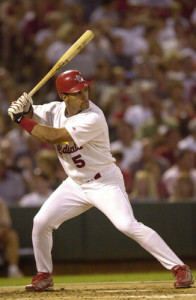
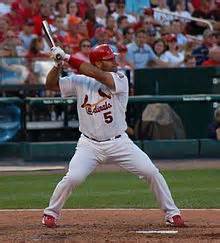
Can Albert regain his former batting prowess by himself, or will he need some help?
One thought on “Albert Pujols: The Rise. – The Fall! – The Resurgence?”